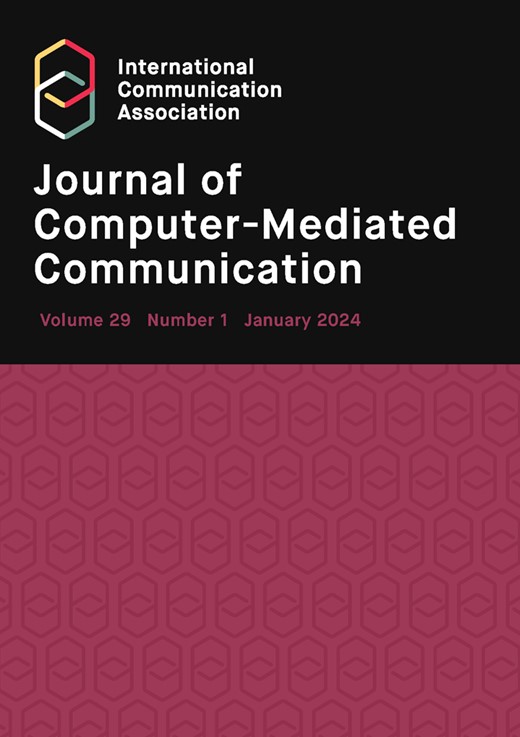个人社交媒体生态系统框架的复制和扩展
IF 5.7
1区 文学
Q1 COMMUNICATION
引用次数: 0
摘要
最近转发的个人社交媒体生态系统框架(PSMEF)允许研究者从广义的用户界面类型来研究社交媒体。本研究通过数字用户界面模型正式扩展了PSMEF,并通过证明存在新的(例如,公开算法内容页面)和验证先前确定的用户界面类型(例如,主页和聊天/消息)来复制先前的工作,这些用户界面构成了个人的个人社交媒体环境。使用主题建模(即潜在狄利克雷分配)和一种新的混合方法方法(即图式语义网络分析),我们基于参与者为六个流行的社交媒体平台(即Instagram, Snapchat, Facebook, Twitter, TikTok和YouTube)提供的开放式描述,定量地证明了四种不同类型的用户界面。研究结果揭示了用户在社交媒体上体验的不同用户界面类别之间的质的差异,并对与社交媒体使用相关的概念化和操作化产生了影响。本文章由计算机程序翻译,如有差异,请以英文原文为准。
A replication and extension of the Personal Social Media Ecosystem Framework
Abstract The recently forwarded Personal Social Media Ecosystem Framework (PSMEF) allows researchers to study social media in terms of generalized types of user interfaces. This study formally extended the PSMEF via the Digital User Interface Model and replicated previous work by evidencing the existence of new (e.g., Overtly Algorithmic Content Pages) and validating previously identified types of user interfaces (e.g., Home Pages and Chats/Messages) that make up individuals’ personal social media environments. Using topic modeling (i.e., Latent Dirichlet Allocation) and a novel mixed methods approach (i.e., schematic semantic network analysis), we quantitatively evidenced four distinct classes of user interfaces based on open-ended descriptions that participants provided for six popular social media platforms (i.e., Instagram, Snapchat, Facebook, Twitter, TikTok, and YouTube). Results inform on the qualitative differences between distinct user interface classes that underwrite users’ experiences over social media, with implications for conceptualization and operationalization related to social media use.
求助全文
通过发布文献求助,成功后即可免费获取论文全文。
去求助
来源期刊
CiteScore
9.60
自引率
2.80%
发文量
26
期刊介绍:
The Journal of Computer-Mediated Communication (JCMC) has been a longstanding contributor to the field of computer-mediated communication research. Since its inception in 1995, it has been a pioneer in web-based, peer-reviewed scholarly publications. JCMC encourages interdisciplinary research, welcoming contributions from various disciplines, such as communication, business, education, political science, sociology, psychology, media studies, and information science. The journal's commitment to open access and high-quality standards has solidified its status as a reputable source for scholars exploring the dynamics of communication in the digital age.

 求助内容:
求助内容: 应助结果提醒方式:
应助结果提醒方式:


